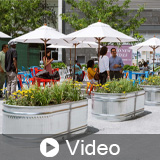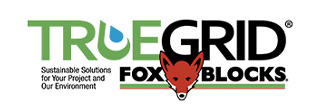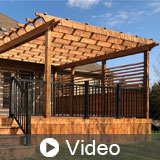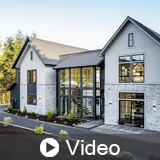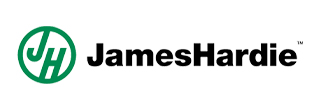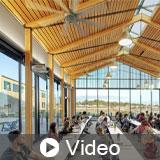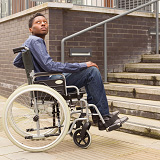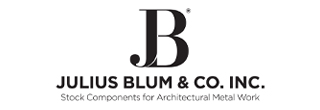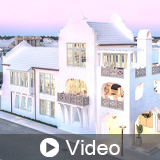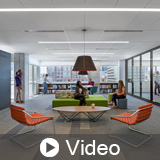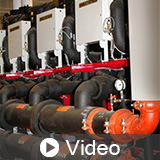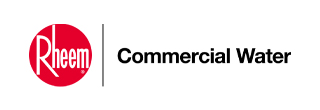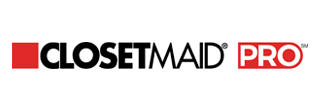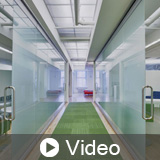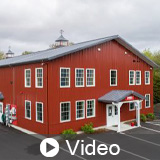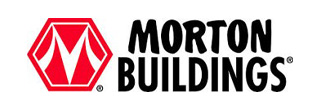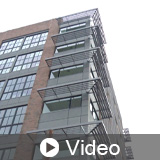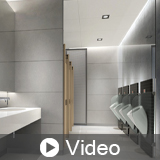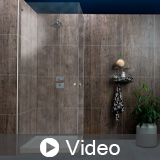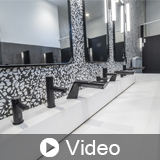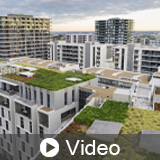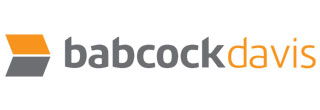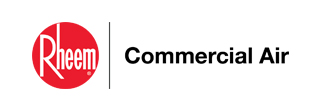In this course we explore how Low Impact Development (LID) has several advantages over traditional stormwater management strategies. Our team discusses LID, its goals and principles, and how they are achieved. The course provides an overview of how plastic permeable grid paver systems support LID goals. We review how LID can help reduce environmental impacts and contribute to LEED v4 as well as reduce hazards for site occupants. Finally, our team examines case studies that show how plastic permeable grid paver systems can benefit projects.
FREE |
|
Imagine you're designing a multi-story residential complex in a densely populated urban area. Suddenly, a fire breaks out on one floor, rapidly engulfing the structure. Now, consider this: What if you had the power to significantly reduce the spread of flames and give occupants more time to evacuate safely? How would you achieve this critical objective in your design?
FREE |
|
Constructing building envelopes designed to withstand extreme weather events and the impact of drastic temperature swings, join us for this one-hour course on building with fiber cement cladding. Participants will examine the importance of building sustainably with fiber cement cladding designed for resiliency to ensure structural stability and life safety. Catastrophic weather events require that the materials that comprise the building envelope are high-performance enough to endure fire, hurricanes, flooding, extreme cold, and heat.
FREE |
|
In this course, we explore how HVLS Fans can contribute to thermal comfort, energy savings, and sustainable design. Our team explores the basics of ASHRAE Standard 55 requirements and new updates to Standard 55-2017 & 55-2020. We discuss how air movement can assist with meeting indoor air quality performance and energy performance requirements for sustainable design projects. Finally, we describe how to evaluate compliance with comfort standards in various environments and how they affect building occupants.
FREE |
|
On September 15, 2010, the Department of Justice published updated Title II and III ADA regulations and adopted the 2010 ADA Standards for Accessible Design. This one hour session will address substantive changes to the regulations and design criteria which became effective on March 15, 2011 and are enforceable as of March 15, 2012.
$35.00 |
|
Architectural railings play a dual role in the built environment, necessitating a delicate balance between elegance and functionality, adherence to codes, and aesthetic appeal. A well-crafted railing not only serves its practical purpose but also elevates the architectural experience, turning a utilitarian feature into a visually pleasing and integral part of the overall design. For over a century, pre-engineered components have simplified the fabrication of handrails and other decorative elements.
FREE |
|
The roof of a building is not only vital as a structural component but can also be an important design feature that makes a building stand out among others. Join us in this one-hour course as we discuss the installation methods of concrete roof tile systems that minimize environmental impact while maximizing durability and design.
FREE |
|
Glass operable wall systems offer a multitude of benefits including adaptability, daylighting, energy savings, sustainability, and occupant well-being. These systems optimize the entry of natural light, creating well-lit spaces that positively impact employee well-being, productivity, and satisfaction. This not only reduces energy consumption but also aligns with sustainable design practices. The adaptability of glass wall systems allows for flexible space configurations, accommodating changing needs and promoting a dynamic work environment.
FREE |
|
In this presentation, we explore the WELL Building Standard and how it can advance human health and well-being. WELL v2 is an evidence-based, technically robust, resilient rating system that can help design professionals create inspiring and healthy buildings. Our team discusses the ten concepts of WELL v2 and performance testing that can help improve occupant health. We examine WELL certified projects and their attributes that make them healthy buildings. This introductory course is aimed at design professionals who want a basic overview of the WELL Building Standard.
$35.00 |
|
Energy costs are soaring across the country and owners are looking for cost-effective and sustainable solutions to provide hot water for their buildings. In this course, we discuss how market conditions and consumer demand are driving the move to Commercial Heat Pump Water Heating (CHPHW) systems. We describe the benefits of CHPHW systems, best practices for design professionals, and how these sustainable products can help improve energy efficiency and occupant experience.
FREE |
|
Join us on this one-hour course as we look at the top ten home storage solutions and bring to life the art of organization. This fundamental question lies at the heart of effective storage design, challenging architects, interior designers, and contractors to transform cluttered closets, disorganized pantries, and chaotic garages into harmonious and functional spaces. Homeowners and renters seek versatile storage solutions for their homes, senior housing, student housing, apartments, hotels, and resorts.
FREE |
|
Moveable walls offer a versatile solution that goes beyond mere spatial flexibility; they contribute significantly to daylight optimization, acoustic performance, utilization of healthy building materials, and enhancement of occupant well-being and comfort. In this course we explore ADA, ASTM, and LEED v4.1 BD+C and ID+C strategies and requirements related to moveable walls. Design professionals will develop the skills necessary to incorporate these principles into their own architectural projects and leverage the benefits of moveable wall systems.
FREE |
|
Post-frame construction is the perfect choice for any low-rise commercial building due to its energy efficiency, durability, versatility, and aesthetic appeal. Join us in this one-hour course as we discuss post-frame construction methods; including foundations, columns, and trusses, as well as materials, coatings, and paint options. By the end of this course, you will be able to demonstrate how post-frame construction can be used in a variety of applications in different markets and provide cost-effective solutions for your project.
FREE |
|
This course discusses the impact of buildings on the natural environment and offers insight on designing to minimize those impacts through sun control and mastery of the elements. The discussion emphasizes implementing design methods including specification of technologies such as sunshade and daylighting canopy systems, as well as materials that contain recycled content. Designing as part of a holistic building environment is critical to optimizing energy performance and reducing extraction of natural resources for building materials.
FREE |
|
During this course, we explore how vacuum plumbing can help design professionals create projects that save water, energy, and money and contribute to sustainable design. We review how vacuum plumbing can help contribute to LEED projects and prevent the spread of infectious diseases, especially during a pandemic. Our team illustrates the differences between vacuum plumbing and gravity plumbing and how they compare regarding sustainability, health and safety, cost and design and use of existing real estate flexibility.
FREE |
|
In this course, we explore how waterproof wall panel systems are used to provide a cost-effective, easy installed, low maintenance design solution for bathrooms and kitchens. We examine the benefits of waterproof wall panels over tile and how panels help prevent mildew and mold. Finally, we discuss how sustainable waterproof wall panels can contribute to LEED v4.1 projects.
FREE |
|
In this presentation, we discuss Computational Fluid Dynamics (CFD) and how it can be used as a tool by building designers to ensure occupant health and safety. We interpret CFD analyses to make design improvements for optimal air movement, cohesive comfort for occupants, and efficiency. Finally, we explain how destratifying a space can decrease HVAC sizing for more efficient and sustainable designs.
FREE |
|
How can commercial restroom design reduce touchpoints, promote proper hand hygiene, and reduce the spread of infection? This course explores this timely question. Attendees will first hear an overview of hygienic restroom design, learning about key elements, such as reducing touching points, improving air quality, and optimizing waste management. Next, the course explores proper hand hygiene techniques, something 97% of consumers fail to do before a meal.
FREE |
|
This course will go over the basics of vegetated roof construction and how the industry has documented successful installations over the last 25 years in the United States. We will teach the design requirements and standards unique to green roofs. The course will educate the participant on the benefits of the technology- including stormwater management and lowering roof temperatures. We will also provide project examples across the country that incorporate a variety of technologies such as biosolar, amenity decks, daylight harvesting, and agricultural production.
FREE |
|
Specifying a sustainable HVAC system is essential for achieving a more efficient, comfortable, durable, cost-effective, and environmentally friendly built environment. In this course, our team discusses why design professionals should specify sustainably manufactured HVAC products that help reduce waste, decrease carbon emissions, and save energy. We review how sustainable HVAC systems can contribute to the LEED v4.1 BD+C rating system and reduce environmental impacts.
FREE |

